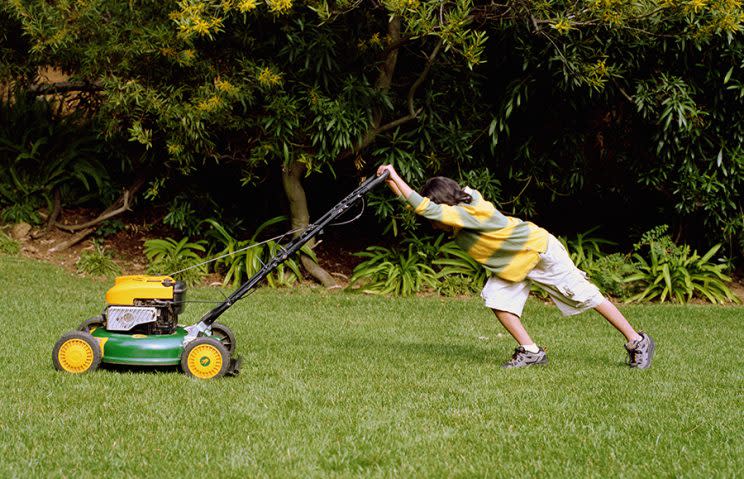Lawn Mowers Are Sending 13 Kids to the Hospital Every Day
When it’s time to cut the grass, it’s best to keep the little ones indoors.
According to research published in the American Journal of Emergency Medicine, approximately 13 U.S. children daily receive emergency treatment for a lawn-mower-related injury, which adds up to nearly 4,800 children each year. Even though this statistic has been decreasing over the last two decades, this type of accident remains a concern due to the severity of the injuries.
Investigators from the Center for Injury Research and Policy at Nationwide Children’s Hospital discovered that the most common injuries were cuts (39 percent) and burns (15 percent. The hands and/or fingers were the most frequently harmed area of the body, followed by the legs, feet, and toes. Even though most children were treated and released, more than 8 percent had injuries serious enough for the children to be admitted to the hospital — with bystanders and passengers being nearly four times more likely than operators to be admitted.

“Improvements in lawn mower design during the last few decades are likely an important contributing factor in the decrease in injuries,” said senior study author Gary Smith, MD, DrPH in a press release. “We would like to see manufacturers continue to improve design and include additional needed safety features on all mowers.”
“Lawn mower accidents are the type of injuries that will often take people to the emergency room, and I think this is a safety topic people don’t always think about,” Dr. Jennifer Caudle, a family physician and assistant professor at Rowan University School of Osteopathic Medicine, tells Yahoo Beauty.
She agrees with the list of prevention tips offered by the researchers and strongly encourages a few of the recommendations that are also cited by the American Academy of Pediatrics. “Number one: Children should not ride as passengers on ride-on lawn mowers,” stresses Caudle. “A parent may have their kid on their lap to take them for a ride on the mower — we don’t recommend that. It’s recommended that children be kept out of the yard while the grass is being mowed.”
Another reason to keep children either indoors — or at safe distance from the mower — is to prevent debris from flying in their direction. “The blades can hit stones and rocks and cause these objects to project,” says Caudle.
She also reiterates the line from the press release: “Always mow going forward.”
“This phrase is consistent with the [American Academy of Pediatrics] because a big worry is about a child being run over by a mower that is in reverse,” says Caudle. “The imagery is really profound — we’ll hear stories about a parent running over a child — so it is such an important reminder that we don’t want to back up.”
The study authors note that every ride-on mower should be equipped with a no-mow-in-reverse mechanism with the override switch for this feature located behind the operator’s seat, which forces people operating the mower to look behind them before backing up with the blades engaged.
Below are the current recommendations from injury-prevention experts. “Keep in mind that a lawn mower is considered heavy machinery, so these tips should not be taken lightly,” says Caudle.
Teach and supervise teens. Children should be at least 12 years old to operate a push mower and at least 16 years old before using a ride-on mower. An adult should supervise teens before they are allowed to operate a lawn mower on their own.
Kid-free zone. Children should never be passengers on ride-on mowers and children younger than 6 years old should be kept indoors during mowing. Never let children play on or near a lawn mower, even when it is not in use.
Before you mow. Pick up any stones or other objects in the grass. Objects thrown by a lawn mower can cause severe eye and other injuries. Put on protective eyewear and make sure you are wearing sturdy shoes.
While you mow. When using a walk-behind lawn mower, use a mower with a control that stops it from moving forward if the handle is released. Always mow going forward. If you absolutely have to mow in reverse, always look behind you before you start backing up.
Turn it off. Wait for the blades to stop completely before removing the grass catcher, unclogging the discharge chute, or crossing gravel roads.
Read more from Yahoo Style + Beauty:
Teenager Saves Mother’s Life 2 Days After Learning About Stroke Symptoms in School
Cruz Beckham’s Workout: Should 12-Year-Olds Be Hitting the Gym?
10 Things Emotionally Neglected Kids Grow Up Believing — That Are NOT True
Follow us on Instagram, Facebook, and Pinterest for nonstop inspiration delivered fresh to your feed, every day. For Twitter updates, please follow @YahooStyle and @YahooBeauty.

